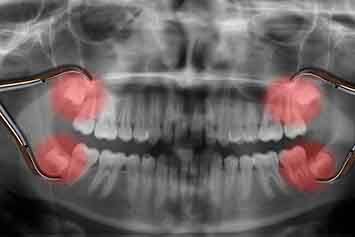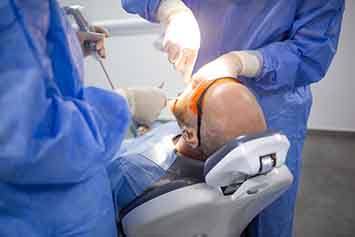Wisdom Tooth Extraction – Waco, TX
A Sensible Solution to Prevent Problems

If you’ve developed an ache in your jaw or notice that the gums around your molars are inflamed, you could be growing your wisdom teeth. These late arrivals show up years after your others grow in and tend to cause more issues than they resolve. Thankfully, our experienced dentists at Dental Station Family Dentistry have a sensible solution to prevent problems. Our team can extract your wisdom teeth before they have a chance to harm your oral health.
Continue reading to learn more about what’s involved in the process, and feel free to contact us with any additional questions.
What are Wisdom Teeth?

These molars grow in the very back of your mouth years after all your other adult teeth have erupted. They typically arrive when you’re between the ages of 17 and 25, which may be why they’re referred to as “wisdom” teeth; knowledge comes with age. It’s believed that humans may once have needed them to maintain an ongoing diet of hard nuts, berries, seeds, and uncooked meat. Today, they’re considered a vestigial feature because they don’t currently serve a functional purpose. We cook our food and use utensils to cut it into manageable bites, so these extra molars are no longer necessary.
Most people have four wisdom teeth, one for each side of their upper and lower arches. However, some only grow one or two, while others never have any at all.
Why Do Wisdom Teeth Need to Be Removed?

In an ideal world, your wisdom teeth would arrive without causing any issues, so there would be no need to remove them. The truth is that they tend to be problematic, so they’re often extracted to keep your dental health intact. If they’re not taken out, you could develop:
- Human jaws are smaller than they used to be, so when these teeth grow in, they frequently push their neighbors out of the way to make space.
- They often are unable to emerge from beneath your gumline and become impacted below the surface.
- Sometimes, these molars partially erupt from your gums, making it harder to brush and floss. Bacteria can penetrate below the surface and cause infection.
- Bite misalignment. If your other teeth are shoved out of the way, you could develop a bite misalignment that can wear down your enamel, cause chips or cracks, or result in TMJ disorders.
- Persistent pain. The constant pressure exerted when these teeth push toward the surface can be incredibly uncomfortable.
What to Expect from the Wisdom Teeth Procedure

If your wisdom teeth have successfully cleared your gumline, then removing them may be a simple procedure. First, our team will numb the area with a topical anesthetic so you remain relaxed. We might also offer sedation if you’re overly anxious or have a hard time sitting still. Then, one of our dentists will grasp the tooth with forceps and wiggle it until it slips out of the socket.
For teeth that haven’t fully emerged or are impacted, then you’ll probably require a surgical extraction. For this method, we’ll start with an anesthetic and/or sedation. Then, we’ll make an incision to access your tooth, which may need to be broken into pieces to be safely removed.
Recovering from Wisdom Teeth Extraction

Once your tooth is removed, we’ll provide detailed post-op instructions that, if followed, can help ensure a smooth recovery. Your mouth must form a blood clot over the extraction site to protect the tender nerve endings and bone tissue beneath, or you could develop a painful condition called dry socket. Some tips for preventing it include:
- Rinse with salt water. For the first 24 hours, avoid brushing and flossing. Instead, rinse with salt water to disinfect your mouth and clear away unwanted particles.
- Drink lots of water. Your body will need to be hydrated to function at its peak so you can heal.
- Avoid straws. The suction exerted when drinking through a straw can dislodge your blood clot.
- Take it easy. Any strenuous activities or exercise that elevate your blood pressure and heart rate can force the blood clot out of place.
- Watch what you eat. Eating anything overly hot, crunchy, hard, or sticky can damage your blood clot. Stick to soft foods that are easier to swallow, like scrambled eggs, yogurt, pudding, and mashed potatoes.
- Address discomfort. If we prescribe pain medications, it’s important to take them exactly as directed. Otherwise, it’s usually safe to use over-the-counter options like Tylenol and ibuprofen to reduce swelling, inflammation, and aches.
If you have pain or bleeding that doesn’t subside or worsens, contact us right away so we can ensure you’re recovering as intended.
Wisdom Tooth Extractions FAQs
How Soon Can I Eat After Wisdom Teeth Removal?
It’s important that you wait at least an hour or two. That way, the gauze pads stay in place (which helps slow down bleeding) and the numbing agent has a chance to wear off (which prevents you from accidentally biting down on your tongue, lips, or the insides of your cheeks).
Once you do get the green light to eat, you should stick to extremely soft foods, like seedless fruit smoothies, plain yogurt, cottage cheese, and pudding. Always check the temperature first too; remember, the area around the extraction site will be more sensitive than usual.
How Should I Prepare for My Wisdom Tooth Extraction?
We mentioned what you should do after your wisdom tooth extraction, but is there anything you should do beforehand? The short answer is “yes!” First, you should not drink alcohol, smoke, or over-indulge on sugary and starchy foods. Second, you should stock up on everything you need – from OTC pain medication to cold compresses and soft foods. Third, you should choose something comfortable to wear the morning of your visit and arrive a few minutes early to fill out any remaining paperwork and settle comfortably into the treatment chair.
Is Wisdom Tooth Removal Painful?
If you need your wisdom teeth removed, but you haven’t scheduled your procedure yet because you’re worried that it will hurt, we have good news: you don’t have anything to worry about. That’s because the first step is always the same: numbing your mouth. Our Waco dental team will also provide you with aftercare instructions so you know exactly what to do (and what NOT to do) to heal comfortably from home.
